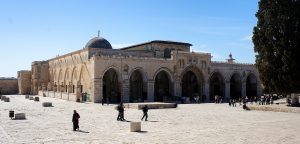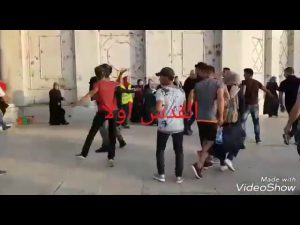Masjid Al-Aqsa is the name for all that is surrounded by the wall located in the far Southeastern corner of the walled city of al-Quds. Which is now called the Old City.
Masjid Al-Aqsa consists of the walls, including the entrance gates, and everything that lies behind those walls, such as the golden-domed Musalla, “Dome of the Rock,” located in the heart of al-Aqsa, and al-Musalla al-Qibli, with its lead dome, located in the far south of al-Aqsa, in the direction of the Qibla, besides all the facilities inside and around them. About 200 landmarks in total, that are all located within the boundaries of al-Aqsa, varying between Musallas, domes, cupolas, public fountains, terraces, aisles, Madaris, Mihrabs, pulpits, minarets, gates, wells and libraries.
With this consideration, the area of Masjid al-Aqsa is about 144,000 square meters – which constitutes about one-sixth of the area of the Old Town. The Masjid has a polygon or semi-rectangular shape, with its dimensions as follows:
Southern side: 281 m
Northern Side: 310 m
Eastern side: 462 m
Western side: 491 m
Based on the above, every part of the walls and what lies within them is an integral part of Masjid al-Aqsa, and any attack on a single part of the aforementioned components in fact is an attack on the entire Masjid.
It is noteworthy that Western references and the occupation’s institutions and maps refer to al-Musalla al-Qibli as Masjid al-Aqsa and this is a serious mistake; because al-Musalla al-Qibli is part of Masjid Al-Aqsa and not the Masjid itself. al-Musalla al-Qibli acts as the main ceiled prayer hall.
This misnomer is most deliberately and purposefully used by the Zionist occupation, in order to mislead and delude the world that the violations and incursions of Masjid Al-Aqsa take place only in its vicinity and not inside the Masjid (al-Musalla al-Qiblib in that sense), hence it becomes easier for them to seize parts of Masjid Al-Aqsa without sparking controversy.
For this purpose, the occupation’s Jerusalem Municipality issued a decision that considers the courtyards of Masjid Al-Aqsa as “public squares,” allowing the municipality to to extend its control over them and control these courtyards as public utilities under the municipality’s authority.


